The 18 Most Common Birds in Central PA Found in Your Backyard
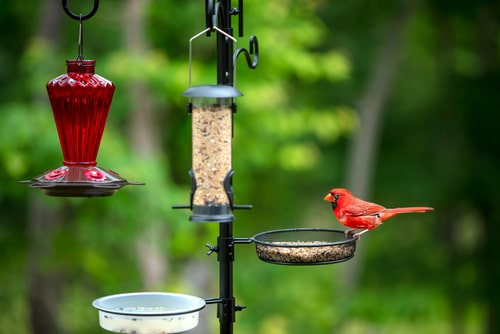
As winter warms to spring, you may find your backyard becoming flocked with a wide variety of birds. Some may be easy to recognize, like the American Robin or Eastern Bluebird. But others might be a bit more unfamiliar like the Tufted Titmouse or Barn Swallow.
Interested in becoming familiar with the feathered neighbors you have been or will be sharing your backyard with? Check out our list of the most common birds in Central PA here to learn the basics and more.

1. American Robin (Turdus Migratorius)
A common bird most well-known and famous for its brownish back and reddish breast, the American robin is easy to spot.
They are often found just as winter is ending, plucking at grass for worms and other small insects. The birds love to sing, so they are often heard chirping and whistling outside (especially during the fall and early winter months right before migration takes place).
Overall, they prefer open areas with short grass to make finding food easier, but will also take up residence in woodlands for coverage from predators.

2. Northern Cardinal (Cardinalis cardinalis)
You can’t miss these bright red birds, especially in the winter. Cardinals are one of many types of birds where it is easy to tell the male and female apart; with the males having the famous red plumage, and females being more brown.
A nonmigratory bird, cardinals prefer habitats such as the edge of woods, gardens, and even areas such as swamps. The males are extremely territorial over the nests and brood, and known for being the only North American red bird with a crest. They also love sunflower seeds and berries.
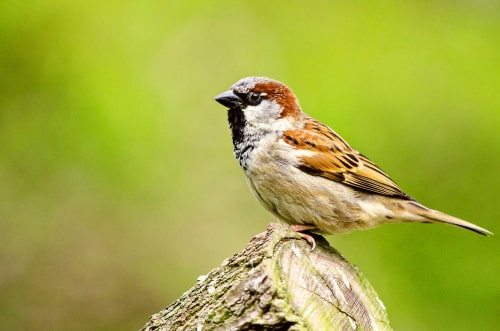
3. House Sparrow (Passer domesticus)
Another common bird you might have seen hopping and chirping through your yard, the house sparrow can be recognized by its stout and stocky build along with its brown with black-streaked body.
This tiny bird was actually introduced from Eurasia and North Africa to Brooklyn, NY in 1851 and spread quickly throughout North America. For this very reason, many house patrons find some annoyance in the sparrow, especially when it scares off other friendly native bird species.
House sparrows tend to gravitate towards human-influenced structures and areas, such as farms and residential/urban areas. They are big fans of taking dust baths, incredibly adaptable to whatever living environment is thrown at them, and will forage via hopping around on the ground.
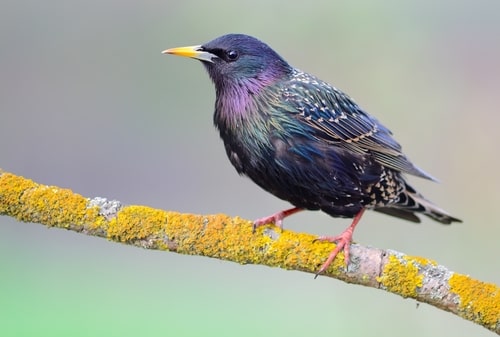
4. European Starling (Sturnus vulgaris)
Dark, stocky, and with plumage that turns an iridescent green and purple in the warmer, sunnier weather, the European starling (as its name suggests) originally came from Europe before being introduced to other continents around the world, making it one of the most common birds around.
Funny enough, these birds were introduced to New York in the early 1890s due to Shakespeare enthusiasts wanting to see the bird in real life.
Like their friends above, European starlings are foragers who are adept at being able to stay in a variety of environments such as cities, parks, and small towns. They’ll mainly eat insects and the occasional berries, and have been known to be strong flyers.
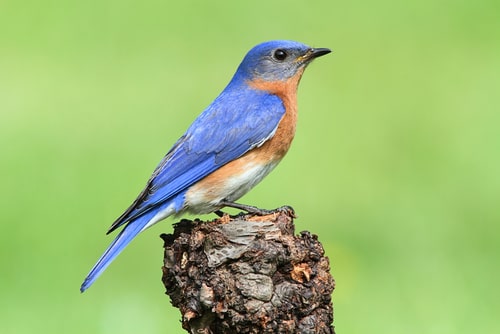
5. Eastern Bluebird (Sialia sialis)
Doubtful anyone can ignore these blue beauties, Eastern bluebirds love open spaces with lots of places to build nests such as tree cavities.
They tend to flock to areas in the early spring that provide lots of food like insects and the occasional berry, but they are well-known for frequenting bird feeders and boxes that provide them with the sustenance and proper nesting shelter they need.
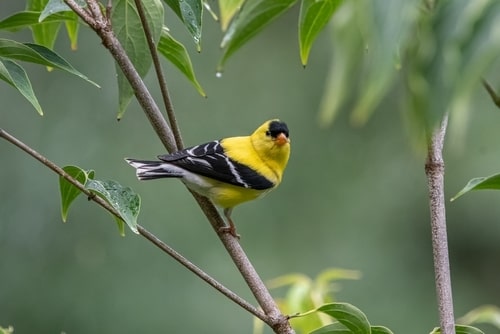
6. American Goldfinch (Spinus tristis)
A bright yellow with dashes of black on its head and wings, the American goldfinch is a very active bird known for its eye-catching colors in the spring weather (especially when mating is at its peak).
They love weedy plants and seeds, so they will often be found in weedy fields and open fields with overgrown foliage and plants like thistles. They are also known for being one of the latest nesters of many most common birds in Central PA.
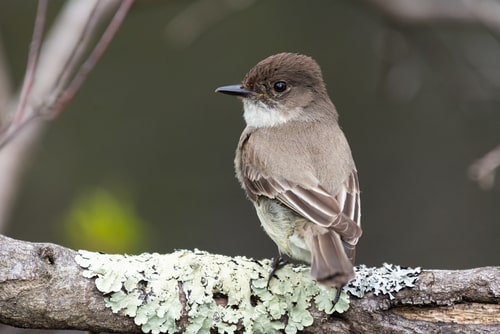
7. Eastern Phoebe (Sayornis phoebe)
The Eastern Phoebe is a plump, brown, and pale songbird with a very thin beak. They are definitely one of the more early migrant flying birds, and tend to stick around areas such as farms and woodland edges for quick flights to grab their insects of choice.
In fact, you may find it cute to know that one of the main reasons why this bird has the name that it does is due to its bird call. To many, it sounds as though they are saying “fee-bee,” which sounds a lot like the name “Phoebe.” Males will even sing to defend their nests from rivals at times too!

8. Chipping Sparrow (Spizella passerina)
Another type of sparrow, the chipping sparrow is distinguished by its gray breast, brown and black speckled wings, rust-red “cap,” and black “eyeliner” markings by its eyes. They also enjoy open woodlands and grassy areas and can adapt well to most environments.
These sparrows will typically forage on the ground for their insects, but love bird seed as well. They also have a loud, trilling sound you may be familiar with when you think of most “woodland/backyard” bird sounds.

9. Tufted Titmouse (Baeolophus bicolor)
This is certainly a cutie you don’t want to overlook! The tufted titmouse makes it easy to imagine where it gets its name from; its soft, gray, and “round” appearance is similar to that of a small mouse.
The bird will stick to woodlands and shady groves, but will take advantage of anything that resembles a nesting cavity. They eat insects like other birds, but are also avid seed, nut, and berry/fruit eaters.
If you are looking to identify this little bird, then keep an ear out for its famous “peter-peter-peter” whistle.
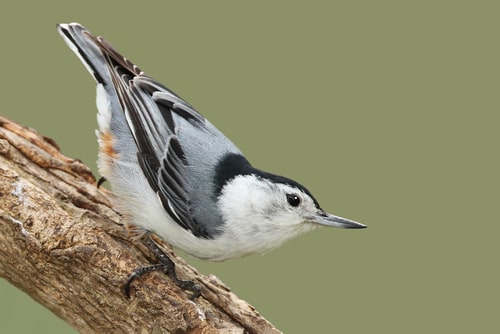
10. White-breasted Nuthatch (Sitta carolinensis)
The white-breasted nuthatch has (as its name suggests) a white chest and face along with blue-gray wings, perfect for blending in within the cool winter mornings. They like woodlands and forest edges and will often go after seeds for food.
Like other nuthatch birds, they like to stick their found seeds and nuts in the crevices of trees and use them to help break their food hauls open with their beaks. You will also find that they like to turn sideways and upside down on vertical surfaces as they forage.
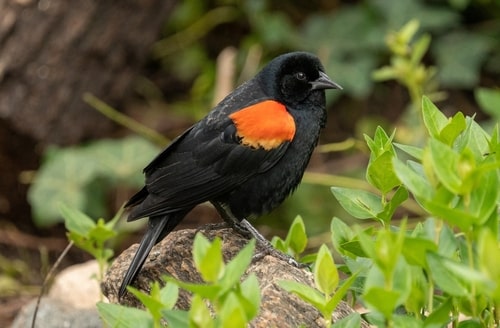
11. Red-winged Blackbird (Agelaius phoeniceus)
Another bird where its name does all the introduction needed, the red-winged blackbird is easily recognizable due to the red and yellow patches of feathers found on the shoulders of its otherwise black wings. Though they are another sexually dimorphic bird, with females being more brown.
They love marshes and other wetland areas, and eat mostly insects and seeds. The males are extremely territorial with their land and females, but are actually polygynous and can mate with several females at once.
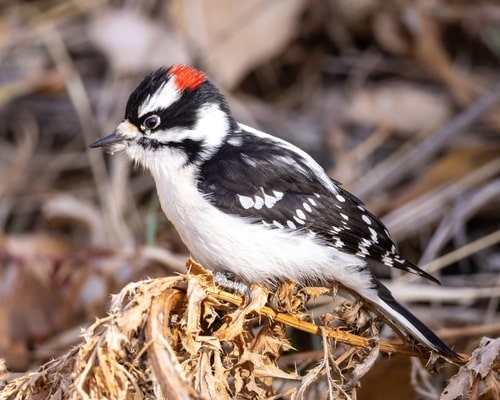
12. Downy Woodpecker (Picoides pubescens)
Our first woodpecker of the backyard birds, the downy woodpecker is the smallest woodpecker in North America. It has a black and white body and wings, with males having a small red patch on top of its head.
They prefer shady forests and woodlands, and due to their agile, small size, they can forage for insects in greenery as small as weed stalks and twigs to as large as towering trees. Due to the nature of their birdcall and pecking noises from digging for their food, these woodpeckers are easy to hear come spring and summer.

13. Pileated Woodpecker (Dryocopus pileatus)
Known for being one of the largest woodpeckers and common backyard birds in North America, the pileated woodpecker is nearly the size of a crow with a black body, a white-striped head, and large, distinctive red crest.
They habit forests and woodlots, and eat mainly tiny insects with the occasional fruit or nut. In fact, more than half of their diets may at times be made up entirely of carpenter ants, which they attempt to uncover by digging rectangular holes into their desired trees.
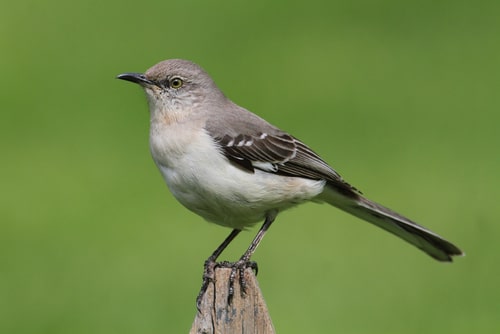
14. Northern Mockingbird (Mimus polyglottos)
It’s impossible not to know who these birds are when one has become familiar with their well-known song. Northern mockingbirds are pale birds with soft gray and white bodies.
They can survive in not just open backyards and lawns, but towns and cities quite well too. They may even end up running for their favorite prey, insects, when they feel the conditions are safe for them.
Who hasn’t become familiar with the mockingbird’s ability to mimic sounds and calls? Some sources say that males can learn up to around 200 different songs during their lifespan, but will also pick up on other noises such as car alarms or even repeated phrases.
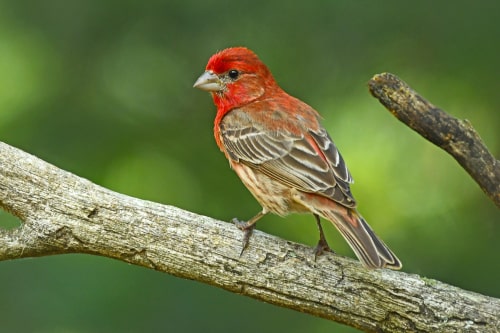
15. House Finch (Haemorhous mexicanus)
House finches vary in color depending on their gender, but their shades change depending on seasons as well. While females remain a less attractive gray-brown color, males will have varying shades of red appear on their brownish bodies.
They also enjoy more human-influenced environments and structures like farms, cities, and towns. They do enjoy most seeds and berries, and will sometimes even eat plant buds.
Like the house sparrow and European starling, the house finch was also introduced into the States and rapidly grew in population after many were released following failed attempts to sell them as caged birds. They tend to sing quite loudly too.

16. Barn Swallow (Hirundo rustica)
Bearing a steel-blue upper side body and a reddish-orange underside, barn swallows aren’t just easy to tell by their color, but by their long, forked tail that fans open when in flight.
Another open habitat-lover, these birds will fields, marshes, lakes, and farms for their food. They mostly dine on insects, but will go the extra mile to catch them while flying, making it a common occurrence to witness their elegant flight-work in the air.
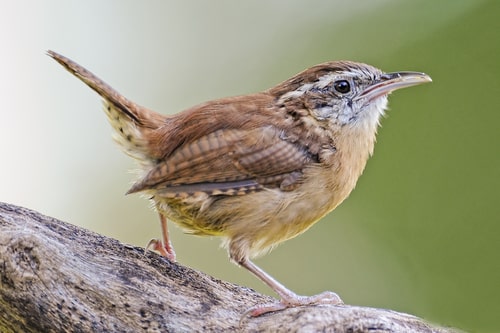
17. Carolina Wren (Thryothorus ludovicianus)
The more lighter-colored birds of the wren family, the carolina wren bears a light brown body and a long, cocked-upward tail.
They tend to hang around areas with lots of undergrowth, and forage mainly for insects (with the occasional small lizard or even frog). They are not big fans of the colder weather, but have big singing voices and will “pair up” for duets where males sing lead and females provide backup noise and chattering.
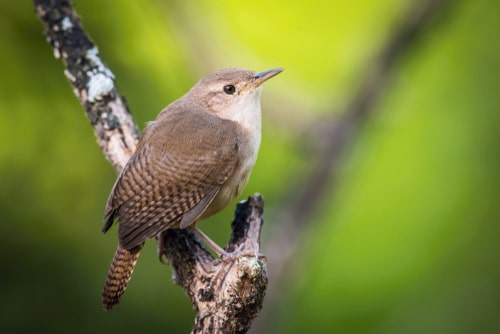
18. House Wren (Troglodytes aedon)
Named for its tendency to frequent and nest around houses, the house wren has a normal, not quite eye-catching brown body with a few smaller dark stripes. And like all wrens, they tend to hold their tails upwards in a signature posture.
They nowadays prefer to habit open woods, gardens, and towns and look for only insects to feast on. House wrens love to house themselves in spaces that cover their bodies fully and are known for having one of the largest ranges among songbirds.
Tips For Bird Watching
Now that you are familiar with many of the backyard birds that can be found nearby, it’s time to prep your lawn and yard for your feathered neighbors. You may even discover some brand-new birds that have never frequented your area before from your efforts.
Don’t worry if you’re new to bird watching. Here are some recommendations we have on how to attract both old and new birds to your backyard.
Gather the Proper Tools to Observe
If you’re curious about the exact types of birds that frequent your area, make sure you have all of the necessary items to help you identify them.
Some items we recommend include (but are not limited to):
- Binoculars
- Bird guide (either a book or an app)
- Video and/or regular camera
- Journal or notebook for recording details about the birds encountered
What you need will vary depending on the layout of your yard or lawn. Adapt to what you need and don’t worry if you find that something’s just not working. Observing birds takes time and patience, and with enough of both, you will surely encounter some of the birds listed above.
Break Out a Birdfeeder
If there are specific types of birds you are looking to attract, or want to see their numbers increase, consider investing in a birdfeeder and feeding your birds.
Some birds have diets that lean more towards seeds and nuts over insects, so leaving a feeder hanging in some trees or by your fence can create quite a positive reaction. Do your research, see what works/is recommended, and then see who will stop by your yard.
Ensure an Inviting Environment For Potential/Returning Birds
Noticing a lack of activity and wanting to attract more birds to your yard? Sometimes, all you need to do is step back and evaluate the environment you are creating.
Many common birds in central PA like open spaces while others rely on a large amount of undergrowth or shady trees for hiding/nesting. They might prefer certain trees and flowers, or want a particular insect to be buzzing around for them to eat.
Become familiar with what birds to expect in your area, and make whatever adjustments to your lawns and gardens. Even consider introducing other plants that can attract helpful pollinators like bees and hummingbirds to give your ecosystem a boost.
Eager to get more involved with all things bird watching? Check out our Birding Page on Stauffer’s Home & Garden to find exactly what you need to attract all of the feathered favorites.
